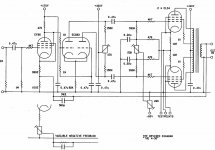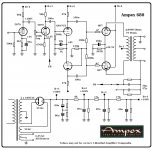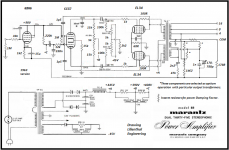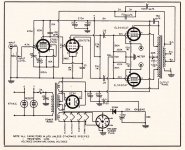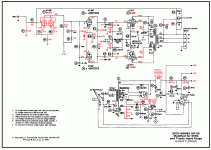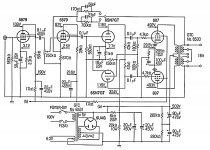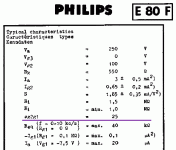Hello Everyone,
Sorry to post what may be something of an opinion-poll type thread. I have decided to build a Push-Pull amp based on either 6L6GCs or El34s. I was pretty much set on building the slightly reworked Mullard 5-20 presented on the Lundahl transformer site (see below).
But then I found a schematic for the Ampex 6516 (see below). This amp uses 807s in the output stage, but I think it could easily be adapted to 6L6GCs--if needs be. I used to own a pair of these in the late 80s/early 90s and have always regretted letting them go.
I am hoping for ~20-30 watts @ 8ohms. Any advice concerning these schematics? I am thinking that the first 5879 on the Ampex schematic could be left off and start the circuit at the 250ohm pot (or leave the pot off and start just after).
Sorry to post what may be something of an opinion-poll type thread. I have decided to build a Push-Pull amp based on either 6L6GCs or El34s. I was pretty much set on building the slightly reworked Mullard 5-20 presented on the Lundahl transformer site (see below).
But then I found a schematic for the Ampex 6516 (see below). This amp uses 807s in the output stage, but I think it could easily be adapted to 6L6GCs--if needs be. I used to own a pair of these in the late 80s/early 90s and have always regretted letting them go.
I am hoping for ~20-30 watts @ 8ohms. Any advice concerning these schematics? I am thinking that the first 5879 on the Ampex schematic could be left off and start the circuit at the 250ohm pot (or leave the pot off and start just after).
Attachments
Difficult question!
I would slightly prefer the 5-20 circuit. But neither of them with quite the given component values.
In the Ampex the cathode voltage of the 6SN7 does not quite compute; there are also other component values which require slight adjustment. And one could use an output transformer with screen taps there rather than output pentodes. (The 8O7 power tubes are equivalent to 6L6s.)
With regard to the 5-20 variant everything is in order. (The lower gain designed in by a Mr. Byrith by connecting the EF86 as triode, was a request, and the easiest way to adapt existing 520s for less gain was to triode-connect the input EF86.) For new builds I find more justification in keeping the EF86 stage as pentode as originally, with rather a lower µ tube as driver/phase inverter, say ECC82 or ECC81 - but that is a longer story. (To my reasoning there is little place for an ECC83 anywhere in a main amplifier.) Should you want to keep that design and your amplifier is stereo then as input tube a dual triode would be more economical than 2 x EF86 triode-connected. Again one can then think of ECC88 or ECC81 - but as said that is a longer story for later, should you want to go that way.
Perhaps to first wait for other comments!
I would slightly prefer the 5-20 circuit. But neither of them with quite the given component values.
In the Ampex the cathode voltage of the 6SN7 does not quite compute; there are also other component values which require slight adjustment. And one could use an output transformer with screen taps there rather than output pentodes. (The 8O7 power tubes are equivalent to 6L6s.)
With regard to the 5-20 variant everything is in order. (The lower gain designed in by a Mr. Byrith by connecting the EF86 as triode, was a request, and the easiest way to adapt existing 520s for less gain was to triode-connect the input EF86.) For new builds I find more justification in keeping the EF86 stage as pentode as originally, with rather a lower µ tube as driver/phase inverter, say ECC82 or ECC81 - but that is a longer story. (To my reasoning there is little place for an ECC83 anywhere in a main amplifier.) Should you want to keep that design and your amplifier is stereo then as input tube a dual triode would be more economical than 2 x EF86 triode-connected. Again one can then think of ECC88 or ECC81 - but as said that is a longer story for later, should you want to go that way.
Perhaps to first wait for other comments!
Hello Johan,
Thanks for the reply. Yes, I have read that the ECC83/12AX7 is not so great as a driver. I have ECC81s and ECC82s to try.
I was also looking at the Marantz 6BH8>6CG7 front-end as an alternative, if going the Mullard 5-20 route.
Thanks for the reply. Yes, I have read that the ECC83/12AX7 is not so great as a driver. I have ECC81s and ECC82s to try.
I was also looking at the Marantz 6BH8>6CG7 front-end as an alternative, if going the Mullard 5-20 route.
Attachments
instead of pentode as input, i used triode, pentode wired as triode and 6SL7 as phase splitters, the mullard 5-20 is as good as it gets..
with today's sources, the amp can use lower gains...
with today's sources, the amp can use lower gains...
I built a modified 5-20, using half an ECC81/12AT7 as the input stage. The ECC83/12AX7 phase splitter works fine, provided that the bias is right so it is not driven into grid current.
I built a modified 5-20, using half an ECC81/12AT7 as the input stage.
Hi DF96,
Going with a dual triode, did you ever try using the two sections in parallel?
I noticed this in David Gillespie's reworkings of the HF-60 (part of a conversion to 6550s which he thinks matches the Eico OPTs better)
According to his write-up this lowers the output impedance to the inverter/driver. Interesting thought.
Attachments
Any more thoughts on the Ampex PP 807 schematic?
I am a little stuck on this one based on past experience with the amps. They sounded quite nice. I can get over it, though... move forward rather than back.
Here is another Schematic of the AMpex 6516. It is a little blurry, sorry.
This one has some differences from the first one I posted.
I am a little stuck on this one based on past experience with the amps. They sounded quite nice. I can get over it, though... move forward rather than back.
Here is another Schematic of the AMpex 6516. It is a little blurry, sorry.
This one has some differences from the first one I posted.
Attachments
No I didn't think of paralleling the triodes. No need, as the LTP input is not particularly difficult to drive. In the circuit you show, the input stage has a low impedance compensation network in its anode - that would be difficult to drive. Maybe that is why he needed two triodes?force of 1/2 said:Hi DF96,
Going with a dual triode, did you ever try using the two sections in parallel?
I noticed this in David Gillespie's reworkings of the HF-60 (part of a conversion to 6550s which he thinks matches the Eico OPTs better)
According to his write-up this lowers the output impedance to the inverter/driver. Interesting thought.
Hi,
So I ended up building the Byrith-Mullard from the schematic on the Lundahl website. They sound very good! Quite agile and snappy.
I have a couple questions:
Johan Potgieter- now that I have built the amps, I want to ask why you would prefer the EF86 run as Pentode-- just as some food for thought moving forward.
My speakers don't seem require a high damping factor, and I think that I like the amps a bit better without the global NFB (if nothing else the slightly drooping HF response without the NFB is good for my wife who has much better hearing in the higher registers. I generally try to get things situated so that she is the one asking to turn up the volume.)
The problem is that without the NFB the amp has, of course, roughly 20db more gain. This puts the main listening volumes right where my cheap Bourns volume pot has the most trouble tracking. I know I have lots of options here:
-Better quality potentiometer
-I could easily reduce the gain in my preamp (right now the pre has about 14db of gain because this is where the circuit sounded happiest to my ear, but it could be lowered to Unity if needs be)
-Go with a passive control section
---OR I could lower the gain on the amps.
If lowering the gain on the amps, my options might be:
-Put a voltage divider at the input (Mr. Byrith suggested this as way to lower noise if NFB is not used), but I am not sure this makes sense.
-Use a lower mU phase-splitter. I dropped in a 12au7. Seems to work fine here, and sounds good, but the gain is only reduced by a couple db. (I know I should probably adjust the working point if I decide to keep the 12au7 here.)
-Use a lower mU voltage amp. The EF86 sounds quite good, but in triode is still giving me roughly 25db (i've also read 30db) of gain. Would something like a 12B4a be a good choice here?
Any thoughts or suggestions are welcome. Quite obviously I am a beginner, but am learning little by little.
Best,
John
So I ended up building the Byrith-Mullard from the schematic on the Lundahl website. They sound very good! Quite agile and snappy.
I have a couple questions:
Johan Potgieter- now that I have built the amps, I want to ask why you would prefer the EF86 run as Pentode-- just as some food for thought moving forward.
My speakers don't seem require a high damping factor, and I think that I like the amps a bit better without the global NFB (if nothing else the slightly drooping HF response without the NFB is good for my wife who has much better hearing in the higher registers. I generally try to get things situated so that she is the one asking to turn up the volume.)
The problem is that without the NFB the amp has, of course, roughly 20db more gain. This puts the main listening volumes right where my cheap Bourns volume pot has the most trouble tracking. I know I have lots of options here:
-Better quality potentiometer
-I could easily reduce the gain in my preamp (right now the pre has about 14db of gain because this is where the circuit sounded happiest to my ear, but it could be lowered to Unity if needs be)
-Go with a passive control section
---OR I could lower the gain on the amps.
If lowering the gain on the amps, my options might be:
-Put a voltage divider at the input (Mr. Byrith suggested this as way to lower noise if NFB is not used), but I am not sure this makes sense.
-Use a lower mU phase-splitter. I dropped in a 12au7. Seems to work fine here, and sounds good, but the gain is only reduced by a couple db. (I know I should probably adjust the working point if I decide to keep the 12au7 here.)
-Use a lower mU voltage amp. The EF86 sounds quite good, but in triode is still giving me roughly 25db (i've also read 30db) of gain. Would something like a 12B4a be a good choice here?
Any thoughts or suggestions are welcome. Quite obviously I am a beginner, but am learning little by little.
Best,
John
if you like the ef86 sound,try the E80F tube .
I have an leak TL25+ clone with custom OPT and the e80f is realy superior .
I am also cable in pentode with too much gain and I think I spend my E80f in triode
I have an leak TL25+ clone with custom OPT and the e80f is realy superior .
I am also cable in pentode with too much gain and I think I spend my E80f in triode
Any idea what the gain factor of the E80F in triode mode is? I looked around and cannot find an answer.
The EF86 in pentode mode is 38, is this correct?
Could one divine that since the "µ" of the EF86 drops from 38 to 25 in triode mode, that an E80F might drop from 25 to roughly 16.5?
(simple math-- 38*.66=25, 25*.66=16.5 --This is probably too simple)
The EF86 in pentode mode is 38, is this correct?
Could one divine that since the "µ" of the EF86 drops from 38 to 25 in triode mode, that an E80F might drop from 25 to roughly 16.5?
(simple math-- 38*.66=25, 25*.66=16.5 --This is probably too simple)
Hi,
So I ended up building the Byrith-Mullard from the schematic on the Lundahl website. They sound very good! Quite agile and snappy......
I remember reading the writeup on that amp.
What output transformer did you use? Any pictures?
I used the suggested Lundahl Transformers LL1663. They were priced reasonably.
I am traveling right now, so no pictures, but if you imagine a few tubes and a bunch of resistors and capacitors soldered to terminal strips and screwed down to a couple plywood rectangles you would have a very good mental image of what they look like.
I like the Bowelist aesthetic of this--like the LLoyds Tower in London, though, not nearly as tall. When I get the amps to a fully finished state, electrically, I will find a way to make them safer. All the B+ connections are tucked away, so one would have to make an effort to touch them, still I could make them a good deal safer. At least there are no pets or children to worry about.
I am traveling right now, so no pictures, but if you imagine a few tubes and a bunch of resistors and capacitors soldered to terminal strips and screwed down to a couple plywood rectangles you would have a very good mental image of what they look like.
I like the Bowelist aesthetic of this--like the LLoyds Tower in London, though, not nearly as tall. When I get the amps to a fully finished state, electrically, I will find a way to make them safer. All the B+ connections are tucked away, so one would have to make an effort to touch them, still I could make them a good deal safer. At least there are no pets or children to worry about.
Any idea what the gain factor of the E80F in triode mode is? I looked around and cannot find an answer.
Right in the datasheet.....
Attachments
The outputs in the 6516 are 10k primary not 4k as shown in the schematic in post 1. If I was to build something with iron like that it would likely be a WE124 clone. I had a few pairs of the 6516 and a pair of 6446 back in the day. I thought the Heath w5m was better than both of them.
Right in the datasheet.....
I thought the μg2g1 was the mu of the tube in pentode connection. Is this not the case?
Last edited:
Sorry. What I meant by the above was that I had assumed that the Amplification Factor in the data sheets (which I read was expressed as "μg2g1" in the Philips data sheets) was a value given for a tube at its full intended potential--i.e. pentode connection for the E80F.
Is the μg2g1 a value assigned to triode connection?
Sorry if this is way too basic a question!
Is the μg2g1 a value assigned to triode connection?
Sorry if this is way too basic a question!
Correct Force!
Sometimes these terms can be confusing until one has become used to the same. It could have stated 'triode µ' - but then using what grid as control grid. . .
Sometimes these terms can be confusing until one has become used to the same. It could have stated 'triode µ' - but then using what grid as control grid. . .
- Home
- Amplifiers
- Tubes / Valves
- Push-Pull 6L6 or EL34 Schematic, Mullard 5-20 vs. Ampex 6516
